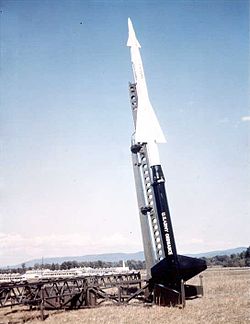Nike-Ajax
| Nike Ajax | |
|---|---|

A Nike Ajax in firing position.
|
|
| Type | Surface-to-air missile |
| Place of origin | United States |
| Service history | |
| In service | 1954–1970 |
| Used by | US Army, allies |
| Production history | |
| Manufacturer |
Bell Labs, Douglas Aircraft |
| Unit cost | $19,300 (flyaway, 1958), $61,000 total |
| Produced | 1952 |
| Specifications | |
| Weight | 32,259 lb (14.6 t) total, 31,051 lb (14.1 t) sustainer, 1,208 lb (0.5 t) booster |
| Length | 32 ft 8 in (9.96 m) overall, 20 ft 11 in (6.38 m) sustainer, 13 ft 2 in (4.01 m) booster |
| Diameter | 14.6 in (0.37 m) sustainer, 16.2 in (0.41 m) booster |
|
Detonation
mechanism |
radio command |
|
|
|
| Engine |
Solid rocket booster, liquid fuel sustainer 48,000–59,000 lbf (210–260 kN) booster, 2,600 lbf (12 kN) sustainer |
| Wingspan | 50 in (1.3 m) sustainer, 76 in (1.9 m) booster |
| Propellant | JP-4 and RFNA/UDMH (sustainer) |
|
Operational
range |
30 mi (48 km) |
| Flight ceiling | 70,000 ft (21,000 m) |
| Speed | Mach 2.25 (1,710 mph; 2,760 km/h) (@ 50k ft) |
|
Guidance
system |
command guidance |
|
Launch
platform |
fixed erector/launchers |
The United States Army's Nike Ajax was the world's first operational surface-to-air missile (SAM), entering service in 1954. Nike Ajax was designed to attack conventional bomber aircraft flying at high subsonic speeds and altitudes above 50,000 feet (15 km). Nike was initially deployed in the US to provide defence against Soviet bomber attacks, and was later deployed overseas to protect US bases, as well as being sold to various allied forces. Some examples remained in use until the 1970s.
Technological development during the 1950s quickly rendered Nike obsolete. It was unable to defend against more capable bombers or multiple targets in formation, and had relatively short range. Even while Nike was being deployed, these concerns led to the contracts for the greatly improved MIM-14 Nike Hercules, which began deployment in 1959. As Hercules developed, the threat moved from bombers to ICBMs, and the LIM-49 Nike Zeus anti-ballistic missile project started to address these. All of the Nike projects were led by Bell Labs, due to their early work in radar guidance systems during World War II.
Originally known simply as Nike, it gained the Ajax as part of a 1956 renaming effort that resulted from the introduction of Hercules. It was initially given the identifier SAM-A-7 (Surface-to-air, Army, design 7) as part of an early tri-service identification system, but later changed to MIM-3 (Mobile Interceptor Missile, design 3) in 1962.
Part of the Nike Ajax development program designed a new solid fuel rocket motor used for the missile's booster. This had originally been designed for the US Navy's missiles, and was enlarged for the Nike efforts. The rocket was so useful that it found numerous applications outside the military world as the Ajax missiles were decommissioned in the 1960s. Many sounding rockets used the booster as their first or second stage, and many of those used "Nike" in their name.
...
Wikipedia
